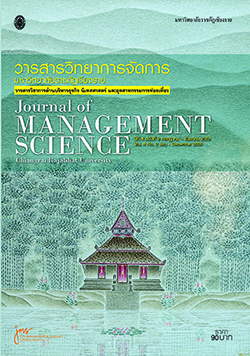Self-Reliance of the Communities Index in Chiang Rai Province
Main Article Content
Abstract
The philosophy of “Sufficiency Economy” founded by His Majesty King Bhumibol Adulyadej has emphasized on Thai people and nations to take middle path of life at all levels: individuals, families, communities and nations. This research aims to study the capability in Self-Reliance of the communities in Chiang-Rai province. The preliminarily data was used as a driving force for sufficiency economy in Chiang Rai Province. The objectives of this research are to conduct an indicator of the community’s ability in Self-reliance and to measure the capacity of community’s independency. These data were collected from both primary and secondary data. The results were revealed that the level of capability in Self-Reliance of the community was a tool to measure an indicator of community’s independency. The framework of this indicator were comprised with fives factors which are as follow; 1) an infrastructure and community’s education 2) capital and economy 3) social and cultures 4) natural source and environment and 5) health concern and public health. Those factors were considered into three dimensions which were the level of community development, the participation of community and the capacity in community’s administration. The results of this measurement were from the community’s seniors, and it was founded that the majority of the villages in Chiang Rai were at B level in capacity in Self-Reliance.
Article Details
Views and opinions expressed in the journal do not necessarily reflect those of the editors.
References
การท่องเที่ยวแห่งประเทศไทย. (2545). แหล่งท่องเที่ยวเพื่อสุขภาพ (Health Tourism). เอกสารอัดสำเนา.
การท่องเที่ยวแห่งประเทศไทย. (2540). สรุปคู่มือการพัฒนาแหล่งท่องเที่ยวทางด้าน
กายภาพ. ม.ป.ท.
ขอนแก่น, มหาวิทยาลัย. ศูนย์วิจัยท่องเที่ยวภูมิภาคลุ่มน้ำโขง. (2548). รายงานฉบับ
สมบูรณ์โครงการสำรวจพฤติกรรมนักท่องเที่ยวเพื่อเพิ่มศักยภาพทางการท่องเที่ยวจังหวัดขอนแก่น.
ขอนแก่น, มหาวิทยาลัย. ศูนย์บริการวิชาการ. (2545). รายงานฉบับสมบูรณ์โครงการ
ศึกษาเพื่อจัดทำแผนปฏิบัติการพัฒนาการท่องเที่ยวจังหวัดขอนแก่น
กาฬสินธุ์ อุดรธานี หนองคาย. ขอนแก่น : ห้างหุ้นส่วนจำกัด ขอนแก่น การพิมพ์.
ประสิทธิ์ คุณุรัตน์ และคณะ. (2546). (ร่าง) รายงานสรุปสำหรับผู้บริหาร แผนงาน
วิจัยย่อยเรื่องการศึกษาและสำรวจเส้นทางการท่องเที่ยวในภาคตะวันออก
เฉียงเหนือ. (เอกสารอัดสำ เนา).
ศูนย์บริการวิชาการ มหาวิทยาลัยขอนแก่น. (2539). รายงานฉบับสมบูรณ์จังหวัด
อุดรธานี: ลู่ทางการพัฒนาการท่องเที่ยวจังหวัดอุดรธานี. ขอนแก่น : ขอนแก่นการพิมพ์.
สมาคมไทยท่องเที่ยวเชิงอนุรักษ์และผจญภัย (สทอ.) (2546). รายงานขั้นสุดท้าย
(Final Report) (ฉบับสมบูรณ์) โครงการศึกษาแนวทางการพัฒนาบริการ
ท่องเที่ยวเชิงส่งเสริมสุขภาพในที่พักแรม.
United Nations. (1960). Guidelines on integrated planning for sustainable tourism development. New York: United Nations Publication.
สื่ออีเล็คทรอนิคส์
เพลินพิศ หมื่นพล. “การส่งเสริมให้ประเทศไทยเป็นศูนย์กลางการแพทย์ของเอเชีย”
จุลสารการท่องเที่ยว ฉบับที่ 4/2547 (ตุลาคม-ธันวาคม 2547) แหล่งที่มา : http://www.etatjournal.com/upland/53/Meditour.pdf. (4 Oct 2008)
ห้องสมุดธนาคารไทยพาณิชย์. “พลังเศรษฐกิจเอเชีย และสถานะของไทย ใน Asian
Supply Chain Network” จุลสารกระแสทรรศ์ ปีที่ 9 ฉบับที่ 1449 (11
กรกฎาคม 2546) แหล่งที่มาhttp://www.scb.co.th/LIB/th/article/kra/2546/k1449.html. (6 Oct 2008)
เว็บไซต์
http://maps.google.co.th/


